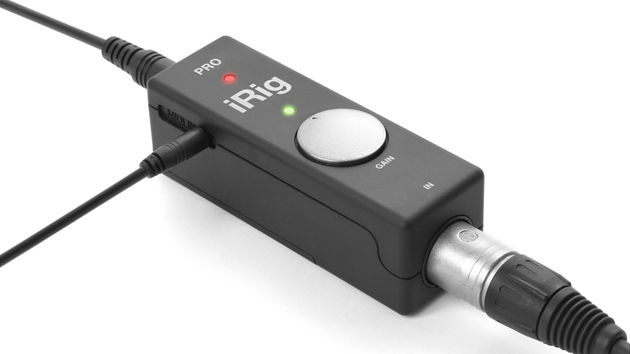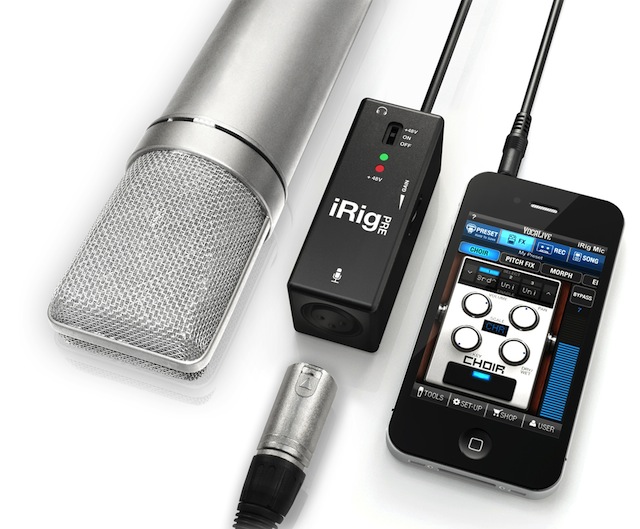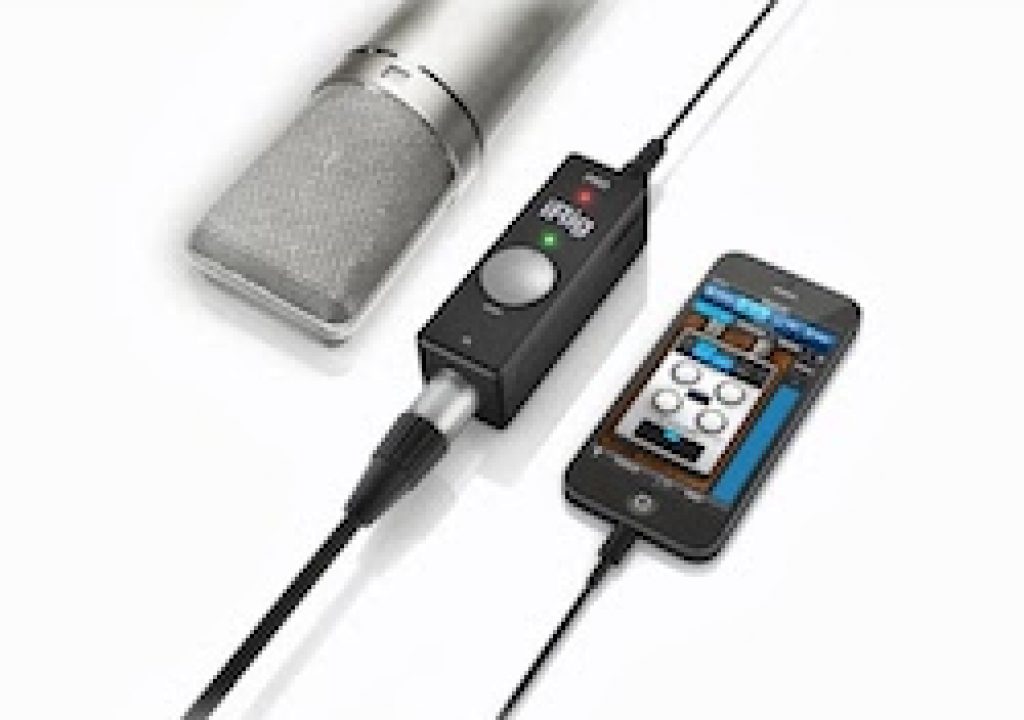
Although I have reviewed many audio preamps and A>D (analog-to-digital) converters, the iRig Pro I am covering here is truly unique for several reasons, two of which are why I purposefully excluded it from my recent roundup of five other preamp + A>D devices for iOS. Ahead you’ll learn everything I love about the iRig Pro for both audio and video, yet why I still can’t recommended the iRig Recorder app for video producers.
Why the iRig Pro is so different from the original iRig Pre?

I reviewed the original iRig Pre back in 2012 and it is still available for under US$40. The original iRig Pre (shown above) is a preamp for Android or iOS devices (iPad/iPhone/iPod Touch), which also routes the device’s own monitoring circuit back out to headphones. The iRig Pre accepts a balanced XLR microphone and does both pre-amplification and impedance matching, while blocking the bias voltage from the connected Android or iOS device (if present). Optionally, the original iRig Pre can supply 48-volt phantom power for those mics that require it. Although the quality of the original iRig Pre is great for its price, the overall quality still depends upon that of the A>D converter which is inside the Android or iOS device. Beyond its original intended purpose, the original iRig Pre has also found a secondary market for those who modify it for use with HDSLR, mirrorless, and video cameras that lack balanced inputs. Just to be completely clear: The original iRig Pre does not do any conversion to digital, as the iRig Pro does, and that’s why I am reviewing the new iRig Pro here in this article.
Why is the iRig Pro so different from the five devices I covered in January 2014?
In January 2014, I published an extensive article called Five iOS-capable, dual-input balanced>USB audio interfaces compared. As the title indicates, those are five devices that have dual balanced inputs, and the iRig Pro has a single balanced XLR input, which is actually a combined connector with 1/4″ TS (tip-sleeve) for unbalanced sources. However, despite that single input, the iRig Pro has unique advantages over the other five devices:
- The iRig Pro is much more compact and lightweight than any of the five devices tested. In fact, the iRig Pro measures 32mm x 105mm x 32mm (1.26“ x 4.14” x 1.26″) and weighs only 40 grams (1.41 ounces).
- At least after iOS was updated to version 7, none of the five devices tested could be powered by any iOS device. On the other hand, the iRig Pro can be powered by the iOS device (even with iOS 7.x) or Mac/Windows as long as phantom power is not required. The iRig Pro only needs a 9-volt battery inside when phantom power is required. The iRig Pro works directly with iOS and Mac. With Windows, it requires the installation of an ASIO4ALL driver.
Due to those three huge differences (number of audio inputs, compactness, and capability of being powered by the iOS device), I knew back in January that the iRig Pro deserved a completely separate article.
Prior teases of the iRig Pro
Frequent readers of ProVideo Coalition magazine already know that I have teased the iRig Pro in a few prior articles, including:
- JuiceLink pre-announces wearable pro audio recorder (April 2014)
- RØDE’s PinMic takes lavalier microphones to a new esthetic level (May 2014)
- CapicúaFM: First podcast I recorded with Bossjock Studio (June 2014, entire program recorded via iRig Pro except for the pre-recorded clips)
- Inexpensive balanced XLR lavalier microphone test (July 2014, including audio recordings via iRig Pro)
As explained in the CapicúaFM article, in that case I used the iRig Pro as an A>D converter, but not as a preamplifier, since the AT-MX351a automatic mixer (reviewed here) was sending balanced line level to the iRig Pro (not mic level). So in that case, the iRig Pro was used without any battery inside, and its potentiometer was set to zero (minimum).
iRig Pro specs and features
As indicated earlier, the iRig Pro has a combined balanced XLR/unbalanced 1/4″ TS (tip-sleeve) input. So far, I have only used it with the mentioned balanced sources, both mic and line. The iRig Pro also has a MIDI input for MIDI devices, of which I have none, so I haven’t used that feature.
The iRig Pro includes four cables: Lightning (for more recent iOS devices, like iPad, iPhone, and iPod Touch), 30-pin (for earlier iOS devices) and USB for Mac or Windows computers. The fourth cable is for MIDI.
I like the input gain potentiometer on the iRig Pro much more than on the original iRig Pre, because the position is immediately clear visually, thanks to the indented dot. I also like the fact that the knob is quite stiff, so it is very unlikely that anyone would move it by mistake. I must note that the range of the knob is not 360 degrees, but much closer to 180. The range (using clock nomenclature) is approximately from 9:00 to 3:00 (or actually a bit more, like 8:30 to 3:30), where in the picture you see it at 12:00 or 50%. This didn’t bother me at all, but I consider it to be worth mentioning. There is a 47 dB range between minimum and maximum. The LED helps you set the ideal level by changing colors as you adjust for a particular input source.
IK Multimedia categorizes the preamp in the iRig Pro as “ultra-low noise” thanks to their “high-definition design”. Regarding the A>D conversion, they classify it as: “highest quality” and 24-bit. The whole purpose of the iRig Pre is not only to adapt the analog audio to feed the computing device (in my case, an iPad Mini Retina), but to do so in such a way so that the computing device’s own audio preamp and A>D converter are completely bypassed. I found the recordings to be ultra clean in all cases, and the comments I have received regarding the first episode of CapicúaFM (which, as of the publication time of this article, has reached listeners in 25 countries according to PodTrac Inc.) included the term “impecable audio quality”.
If you’re interested in subscribing to CapicúaFM, it’s available free via iTunes and Stitcher Radio, as well as via premium podcast catchers like PocketCasts, by simply searching for the CapicúaFM name within the app.
That compliment I received is a testament to all three pieces of audio hardware that were responsable for the overall quality (other than the few pre-recorded clips):
the versatile hybrid AT2005USB microphones, the AT-MX351a automatic mixer, and the iRig Pro.
The iRig Pro includes a 9-volt battery. I only used it for the first test with the PinMic and MXL lavalier mics, which require phantom power. The other tests did not require phantom power, so I removed the battery from its compartment.
Applications included from IK Multimedia
IK Multimedia includes several music production apps, some for iOS and some for Mac. I didn’t used any of them since I am not a musician. IK Multimedia also offers two versions of an audio recording application called iRig Recorder. Unfortunately (just as I stated back in my 2012 review of the original iRig Pre) I still cannot recommend either version the iRig Recorder, since neither the free nor the paid version yet supports 48 kHz. Instead, the iRig Recorder app is still limited to 44.1 kHz only. As stated in many prior articles, 48 kHz is the absolute standard for audio sampling for digital video. Whether we are talking about DVDs, Blu-rays, or HD videotape formats (like HDV, Panasonic’s DVCProHD, Sony’s HDCAM or HDCAM-SR), or DCP, the standard sampling rate is 48 kHz. Although online video services like Vimeo Pro and YouTube will accept non-standard video with audio sampling incorrectly sampled at 44.1 kHz, nothing is gained by sampling the audio at a non-standard rate, since Vimeo Pro and YouTube will also accept videos with the standard 48 kHz audio. Until IK Multimedia adds support for 48 kHz, I must continue to recommend the RØDE Rec audio app instead for anyone involved with video production, or for recording video on iOS, I recommend FilMiC Pro, which also supports 48 kHz. Fortunately, the designers of the iRig Pro made the hardware for both 44.1 and 48 kHz, as I verified, and it works.
Conclusions about the iRig Pro
Thanks to its compact yet rugged design, pristine audio quality, stiff input gain potentiometer with visual feedback both mechanically and via LED, and iOS power capabilities (when phantom power is not required), I recommend the iRig Pro without any reservation for a single mono source, be it mic or line, balanced or unbalanced.
Upcoming articles, reviews, and books
Stand by for upcoming articles, reviews, and books. Sign up to my free mailing list by clicking here.
Si deseas suscribirte a mi lista en castellano, visita aquí. Si prefieres, puedes suscribirte a ambas listas (castellano e inglés).
My latest book (paperback + ebook)
My most recent book is available in two languages, and in paperback as well as an ebook. The ebook format is Kindle, but even if you don’t have a Kindle device, you can read Kindle books on many other devices using a free Kindle app. That includes iPad, Android tablets, Mac computers, and Windows computers. Although generally speaking, Kindle books are readable on smartphones like Androids and iPhones, I don’t recommend it for this particular book since it contains both color photos and color comparison charts. The ebook is also DRM-free.
In English:
In English, it is currently available in the following Amazon stores, depending upon your region:
- Amazon.com, for the US and other countries in the Americas that don’t currently have their own Amazon store, or anywhere if you simply prefer it
- Amazon.br for Brazil
- Amazon.ca for Canada
- Amazon.de for Germany
- Amazon.es for Spain pero a lo mejor lo preferirás en castellano, a continuación)
- Amazon.fr for France
- Amazon.in for India
- Amazon.it for Italy
- Amazon.co.jp for Japan
- Amazon.com.mx for México
- Amazon.co.uk for the United Kingdom
Or in your favorite bookstore by requesting ISBN–10: 1456310232 or ISBN–13: 978–1456310233.
En castellano:
En castellano, está disponible actualmente en las siguientes tiendas Amazon, según tu región:
- Amazon.com para EE.UU. y todas las Américas donde no existe ninguna tienda particular… o en cualquier parte si simplemente lo prefieres
- Amazon.com.br para Brasil
- Amazon.co.jp para Japón
- Amazon.de para Alemania
- Amazon.es para España
- Amazon.fr (Francia)
- Amazon.in para India
- Amazon.it para Italia
- Amazon.com.mx para México
- Amazon.co.uk para el Reino Unido
o en tu librería preferida al solicitar el ISBN–10: 1492783390 ó el ISBN–13: 978–1492783398.
Allan Tépper’s other books, consulting, articles, seminars & audio programs
Contact Allan Tépper for consulting, or find a full listing of his books, articles and upcoming seminars and webinars at AllanTepper.com. Listen to his TecnoTur program, which is now available both in Castilian (aka “Spanish”) and in English, free of charge. Search for TecnoTur in iTunes or visit TecnoTur.us for more information.
FTC disclosure
No manufacturer is specifically paying Allan Tépper or TecnoTur LLC to write this article or the mentioned books. Some of the other manufacturers listed above have contracted Tépper and/or TecnoTur LLC to carry out consulting and/or translations/localizations/transcreations. Many of the manufacturers listed above have sent Allan Tépper review units. So far, none of the manufacturers listed above is/are sponsors of the TecnoTur programs, although they are welcome to do so, and some are, may be (or may have been) sponsors of ProVideo Coalition magazine. Some links to third parties listed in this article and/or on this web page may indirectly benefit TecnoTur LLC via affiliate programs.
Copyright and use of this article
The articles contained in the TecnoTur channel in ProVideo Coalition magazine are copyright Allan Tépper/TecnoTur LLC, except where otherwise attributed. Unauthorized use is prohibited without prior approval, except for short quotes which link back to this page, which are encouraged!


